Reviews2

ON THE BRIDGE OF DEATH AND LIFE
By Panchali Kar
Nanjing Yangtze River Bridge On the Bridge of Death and Life documents the life of rescue worker Chen Si, whose mission is to save people from the brink of death. He holds the record of saving more than 200 people from committing suicide by jumping off the river bridge. The plot revolves around the very famous Nanjing Yangtze River Bridge, which is being crosses by hundreds of people every day; however quite a good number of people come here, not to return back, ever. Chen Si plays the vital part of sending them back to where they belong to: Life. The documentary is well compiled, keeping the primary focus on Chen Si and his humanitarian activities; at the same time, the relevant information like the sociopolitical background, the historical significance of the bridge, and the dilemma between post-communist dreams and the harsh laws of unmitigated capitalism, which has affected the life of people in China to a great extent, have been provided to the viewers neatly, without disrupting the flow of the narrative. Chen Si shares the nitty-gritty of his passion over a heartfelt conversation. Also, survivors who have been rescued by Chen Si, throw light on his initiative from their perspective of coming back to life. The biggest plus of this documentary is in its realistic approach in portraying Chen Si as a regular person. It does project Chen Si as a Hero and at the same time, it wonderfully documents the void in his life. Chen Si talks about how exhaustive it is to take away so much negativity from all around. His work involves listening to people, being patient and compassionate all the time; being empathetic to build up the trust; being alert attentive; being physically and mentally strong, and so much more. He also has a family and has things to take care at home.
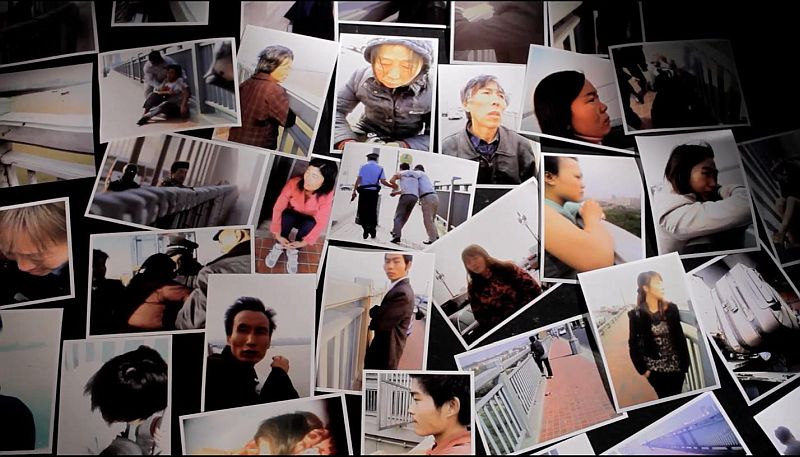
In an ideal world we expect our heroes to show their prowess and not complain, however in real life, it drains a person to the rock bottom to play so many roles at the same time. The same has been conveyed in his daughter’s response as well. Chen Si is the hero in spite of feeling empty, because no matter what, he goes back to the bridge, without taking a single week off for years, so that he could help the people who really need it. The film is technically smart in making. Natural light, hand held shots, imperfect framing … nothing looks staged in the journey of one and a half hours; not a single element that would distract the focus of the spectators from the main narrative. The approach of filming has in turn has made the central character of the film more believable towards the audience. No matter, how much the tough times engulf our state of mind, suicide is never a solution. Human beings sometimes lose control over their logic and tend to give up on life, what they need is a ear that would listen without passing any judgment, a shoulder to vent out the dormant tears, a hand to hold and lift you up. As Chen Si himself conveys: It is easy to save a life.
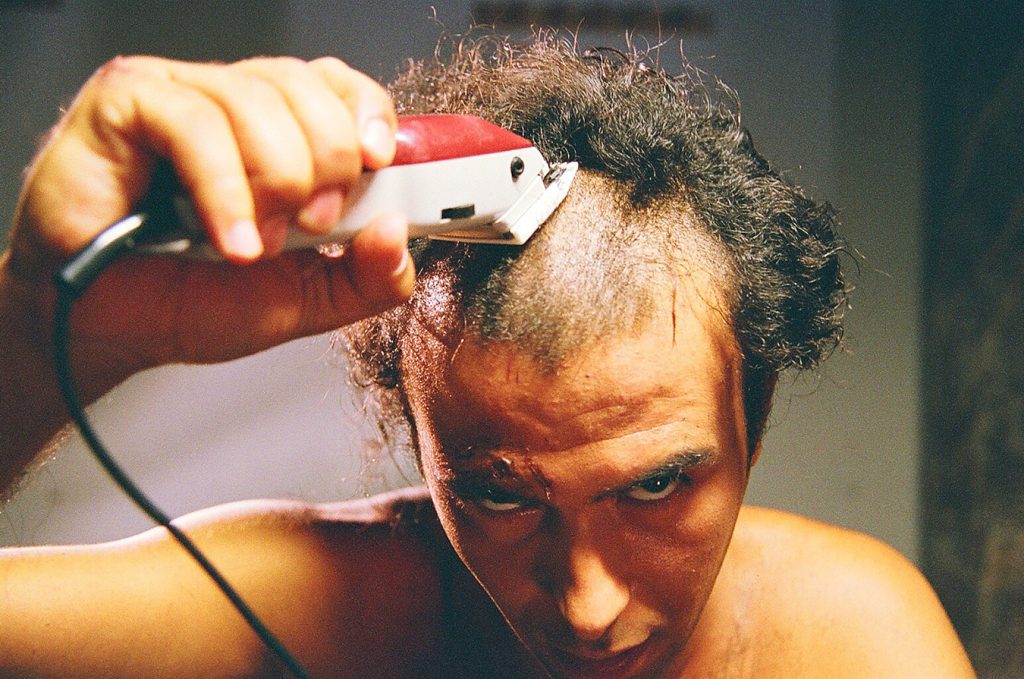
“The problem with fundamentalism is beyond the light of reason. The logic of settling the score has been revived. As if the prophet were still here. People don't realize that this distorts the true meaning of Islam.”
ENEMY OF ISLAM? A MEETING WITH NOURI BOUZID
By EJ Wickes Image (above) from "Making Of" It takes a lot of courage to challenge people to see the world through your own eyes. Especially when the “delivery system” overshadows the payload. In his documentary film, Enemy of Islam? A Meeting with Nouri Bouzid, Stefano Grossi engages the controversial Tunisian filmmaker, Nouri Bouzid. Bouzid does not speak favorably about his ethnic history or religion, even though he sincerely cares about his people's destiny. Before this film ignites the flames of contention among you, be careful to observe the various interpretations of Islam that each character represents. The film grabs our attention from the beginning with a haunting shot racing us toward the burnt out husk of a truck across the Arabian desert. Segments of Bouzid's films are layered into the documentary. With a touch of mise en abyme we're led on and off the set by a series of onset conflicts and dialogues between Lofti and Nouri about the morality and the politics of the picture, Making Of (2006). The tension is raised when the young dancer, Lofti walks off the set. The script requires his fundamentalist employer to condemn his preoccupation with modern dance as a sin. Lofti's version of Islam is not characterized by any fundamentalist's version. This unforeseen twist angers him and he feels as though he has been lured into a dangerous situation by Bouzid that will lead to serious consequences. Lofti is a dancer and as an artist his aspirations are also contradictory to fundamentalism. Ironically, as a Muslim devoted to Islam, he's as guarded with his own Islamic beliefs as the radical Islamic fundamentalist, or Jew, or Christian might be with their own belief systems. The young actor has trouble seeing that both he and Nouri are climbing the same mountain, but not necessarily taking the exact same path. With reference to the revolution and observations of a country torn, this documentary shows without bias, Bouzid's exposure of the cruelty and hypocrisy of the cultural facade of Tunisia and the Arab state. This documentary features a cross section of Bouzid's films which embellish his rebellious tendencies including, Man of Ashes (1986) and Millefeuille (2012).
“It is our intention to discover the Maghreb through the often unexpected view that its cinema, particularly that of Tunisia, has been able to reveal in the works and commitment of its directors and producers; men who have often been obliged to operate in a difficult if not openly hostile sociopolitical context (as recent events have abundantly demonstrated). This choice is justified by the need to present a different culture to a Western audience without prejudice: the culture of 'the other', usually described by the media with an ideological bias, stressing its negative and pathological aspects.”

ONCE UPON A DREAM
By Arindam Bhunia Sarah Brunel (above) and Thomas Jeand'heur How much difference is there between a dream and reality? Is there any parallelism or equivalence between the persons of our fantasy and actuality? Or else when we come into possession of the real love of our life our hallucination becomes extinct? Well, you may get answers to all of those questions in Anthony Nion’s short film ‘Once Upon A Dream'. Velentin, a wordsmith falls in love at first blush to the very beautiful and charismatic Ludivine and in order to impress Ludivine he takes a utopian scheme like hallucination. He makes Ludivine believe that she is the fantasy girl of his dream. Gradually the duo became paramour. The twist of the story comes then. Ludivine devastates when Velentin makes a confession that the girl of his hallucination was none other than the Hollywood diva Natalie Portman. But yes, here film director Nion has established the essence of eternal love and the pure, overwhelming love of Velentin makes much to Ludivine. It is difficult for a filmmaker to establish a very particular and distinctive direction in a short film. With such an amorous and off-centre story, director Anthony Nion has passed with distinction. Films that aren’t intelligent often end up as entertainment. This myth has totally missed the mark in the case of ‘Once upon a Dream’. All the thirteen minutes and twenty five seconds is a package of intelligence as well as entertainment and romance. In the aspects of direction Anthony Nion stresses his experience remarkably. Characters won the screen and their body language was pitch perfect. The background music serves as the perfect foil. In a whole the movie will floor you with its deliberate pacing, uncluttered simplicity and understated joie de vivre.
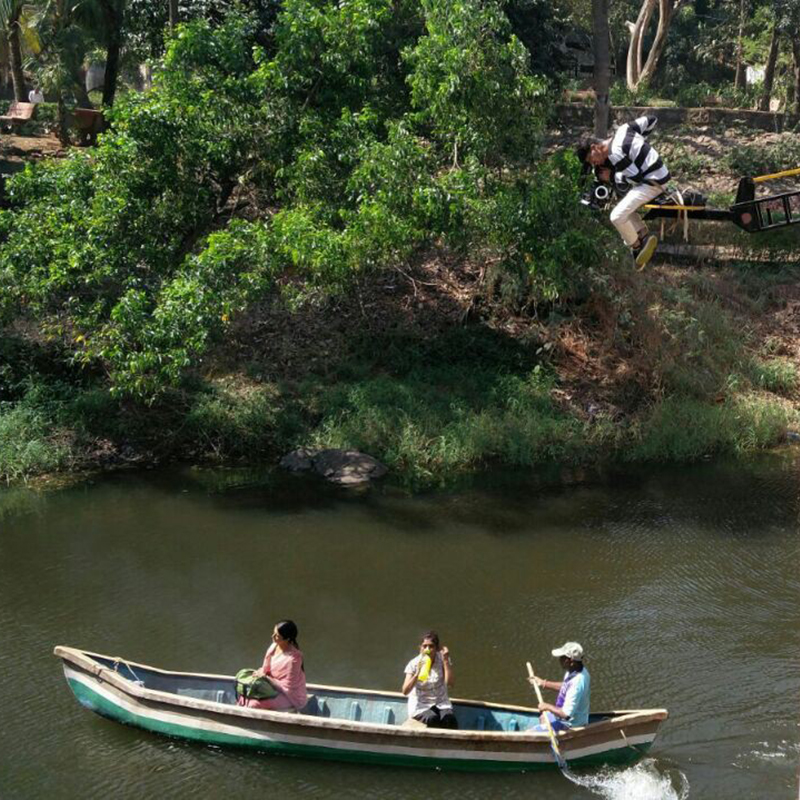
THE BUTTERFLY
”Poetic and beautiful, subtle and full of strength. The title is a shape for this beauty.” By Daniela Lucato Crane shot (above) from The Butterfly The film, The Butterfly is a journey into the intimacy of a woman; her erotic desire; her emotions and fragility. We follow the fantasy and feelings of the protagonist in the symbolic and stunning images, original in their composition, that look partially real partially projections of her mind. The text is minimal because it is not needed, the music emphasizes the feeling of not just watching her but also feeling what she feels, following the intensity of her senses. The Butterfly is a story of a symbolic passage, a transition from a status (undeveloped) to another one (the butterfly), a travel in the intimacy of a woman, in her erotic desire, in her emotions and fragility. After having lost her husband, Anamika visits her grandmother and spends sometime in her village. For the first time she confronts herself and her life understanding who she has been until now, the indecision that makes her incapable to give a direction to any choice she has to make. The arrival of Anamika in the small village opens a new dimension to her: she learns to discover and explore in the way children do. The world is now not only pain, it is pleasure too. Anamika explores the world again for the first time with a new consciousness and perception: back to the place where she grown up, she experiences a kind of “re-birth” where she touches, smells, feels, sees as if she does it for the first time. We follow her fantasy and feelings in the symbolic and stunning images, original in their composition, that look partially real, partially projections of her mind. The text is minimal because it is not needed, the music emphasizes the feeling of not just watching her but also feeling what she feels, following the intensity of her senses. Her new way to watch a man and the natural attraction for him is an effect of Anamika's transition and the result of perceiving herself as a new woman who doesn’t judge herself anymore. The film reflects on the power of life: when we think we have discovered everything, we magically see a new chapter coming where things appear us how we never see them and we finally enjoy them as we never did.
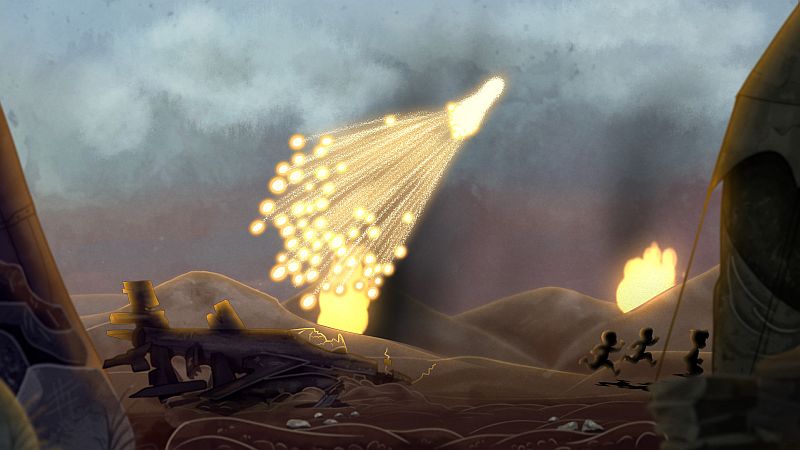
THE BOX
By Sandip Pratihar “One child waking up homeless on Christmas morning is a tragedy.” The Syrian Civil War is without doubt the worst and most brutal conflict in the world, a generational war without any real historical comparisons. The box in this story means a lot. A strong symbolic metaphor to what we as children found comforting about a box. Toys, anything to keep the place. In this film The Box has been used as a home; a place of sanctuary. The little boy playing with his pet cat that was amazing combination within the little universe of The Box. The bond between them was more than compelling. I’m really afraid of how the children will ultimately survive this war.
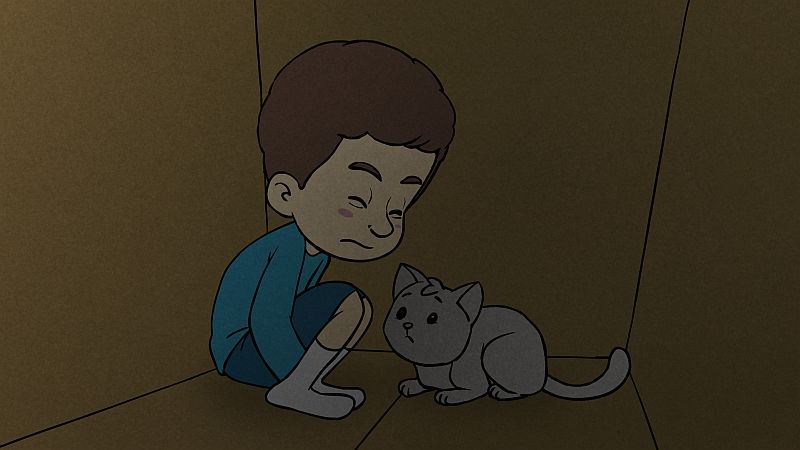
"The happy life of a Syrian kid alters instantly with the sudden war and he finds himself in a state of struggle. The war changes not only lives, but also the role of his box; first as a carefully built toy house, then as a place to take shelter in a refugee camp with full of dangers and finally as a boat that sails for a journey towards hope." About this film Director: Merve Cirisoglu Cotur has created an incredibly emotional study, through this animated short, of the heartbreaking conditions of war. When the little boy loses his modest space and embarks on his journey, while carrying his little folded house, I couldn't help thinking how awfully dramatic of a scene it was. And the last scene is so touching, you can just close your eyes and see the whole wretched conditions caused by this horrific civil war.
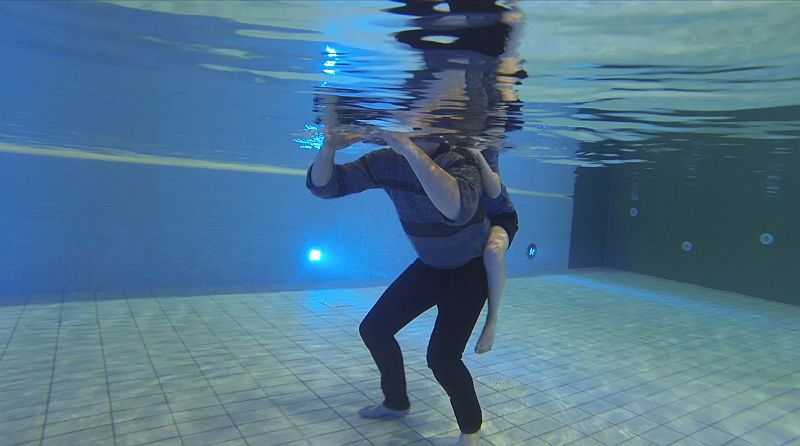
PAPA UNDERWATER
“Have you ever felt like you’re underwater? Everything is happening around you. Things appear blurry. Sounds are distant. The water envelopes you, resists you as you push against it, stroke after stroke.” By Shevaun Cavanaugh Kastl Image {above) from Papa Underwater Our emotions can make us feel this way sometimes. Like we’re submerged in our own subconscious. And the most important relationships feel distant, blurry and out of touch...Especially for a child. Papa Underwater is a delicate but deliberate family drama about a young boy quietly but desperately missing his father’s attention and care and the fish who saves them both. Manuel is growing up alone. His father is pre-occupied with work and though just down the hall, might as well be an ocean away. To deal with his loneliness, Manuel turns to his pet fish, his best friend and constant companion. But when misfortune strikes and Manuel’s fish accidentally falls through the street grille of a basement window well, his father comes to his aid and saves the fish. The small encounter reminds both father and son of the bond they share. Manuel’s last thoughts as he drifts to sleep in his father’s arms are of the two swimming underwater.. together. At the end of the day, more than a fish was saved. Student director Joas Welf Reinhart does a lovely job at moving gently through each scene, and for a short film the story is beautifully modulated. What impressed me most is how intentional the film is.. From the imagery to the placement of dialogue to Pablo Anson’s whimsical scoring. There’s a lyric quality, a light, but deliberate touch much like a father’s guiding hand on the small of a child’s back.. Interesting, since the story is about a child craving that very guidance and safety from his own father. Another intentional move by Reinhart, I am sure. In his role as director, he imparts this paternal quality to enhance the connection between the viewer and lonely Manuel. We feel his father’s absence as keenly as he does. Christoph Grunert and Nelio Neumann deliver nicely nuanced performances as father and son. And the end montage between them is beautifully rendered. From underwater play to making paper boats before bed to falling asleep in his father’s arms. This film took me back to how I felt as a child. Being so vulnerable but knowing that as long as my Dad was with me I was safe. We all sometimes feel like we’re underwater. Everything is happening around you. Things appear blurry. Sounds are distant. The water resists you with every stroke as you swim for the surface. In these moments, we’re all children again and what a difference it made all those years ago when Father was there to pull you in and carry you on his back.

SCHIRKOA
”Perfection can be a little unforgiving sometimes.” By EJ Wickes Image (above) from Shirkoa Welcome to Schirkoa. Imagine a place where immigration was considered a plague. Where no identity was preferable to any identity. A society of faces made bland and generic by decree. The Bag Act was the new law of the land, enforced by the intellectuals of a dystopian society. That's the story behind Schirkoa, the short film written and directed by animator Ishan Shukla. This beautifully animated short tells the story of a dismal metropolis where everyone hides their identities for fear of persecution. This is a place where a good alias is everything. The main character identifying herself only as “Little Whore”, narrates the tail as she describes her first meeting and the relationship she has with a mysterious bureaucrat known only as “197 A”. One day the bureaucrat decides to end it all by jumping off a building. Before he leaps, he meets the gaze of a woman from another rooftop, preparing to do the same. Our storyteller never sees her mysterious bureaucrat again, but lives on to witness and describe the events that follow. A relationship between the “White Witch” and 197 A ensues, leading to a twisted plot laced with love, betrayal and chaos. Most certainly a “cartoon” for adults, Schirkoa is an intelligent piece of visual art with a strong social message, as well as being completely entertaining. I could see this short film being the prototype for a much longer feature or a series. The film created a frighteningly curious world with a rich storyline and compelling visual effects. It engages and gives cause for reflection on the most frightening aspects of a postmodern society revisited by coercive “nationalism”. For a thirteen minute film, the invested craftsmanship in the soundtrack and animation was well worth it and due credit should go to the other animators as well; Yiming Lim, Nico Agatha Wibowo and Milan Padhiyar. The music and sound design were exquisitely composed and scored by Nicolas Titeux and I look forward to seeing more work from Indian filmmaker Ishan Shukla and his fellow animators.
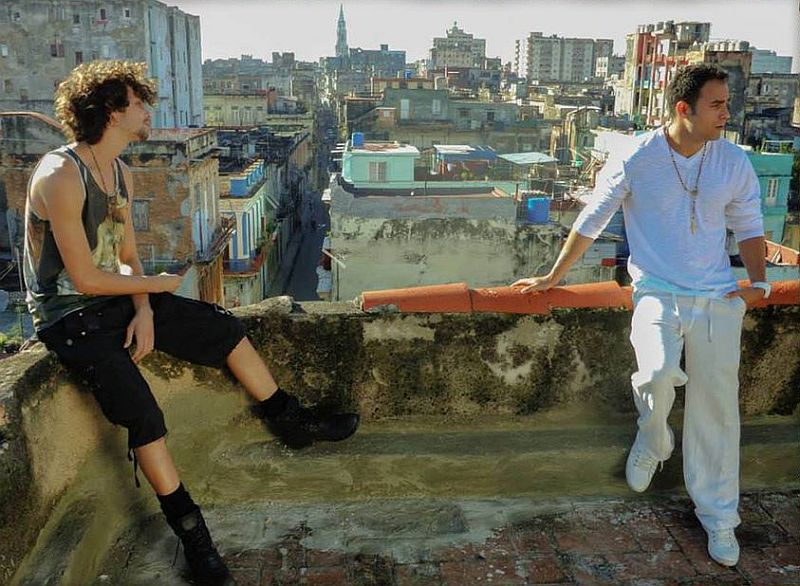
UNA HISTORIA CON CRISTO Y JESÚS (A TALE WITH CHRIST AND JESUS)
By E.J. Wickes Image (above) from Una Historia...” The story revolves around two men who happen upon a chance meeting. Jesus and Christ. As the relationship develops we see the attraction from two opposite extremes. Jesus, the well groomed student with the absentee father and domineering mother and Christ, the pensive artistic survivor with no consistent support system, who seems to be living on the street. The film begins with scenes of Christ suffering a harsh childhood. He never got over the loss of his mother; the one comforting memory he had left from a history of violence and sexual abuse. Jesus lives the opposite extreme with a judgmental and overbearing mother, who is very condescending of Christ's appearance and lifestyle. Never having to suffer such neglect or rejection, he admires Christ's resolve, a key dynamic in his attraction to him. In some ways both men become “saviors”. As Christ walks the streets and shows kindness among the “unclean” of Cuban society, Jesus become Christ's friend and pillar of strength. Christ is an angry young man. He wears it like a badge, never complacent to anyone's expectations. His love affair with Jesus becomes a positive encounter in his life to pacify his anger and sadness. And as if a crucifixion was eminent, the plot builds to its foreshadowed ending after a casual altercation with a troublemaker occurs.
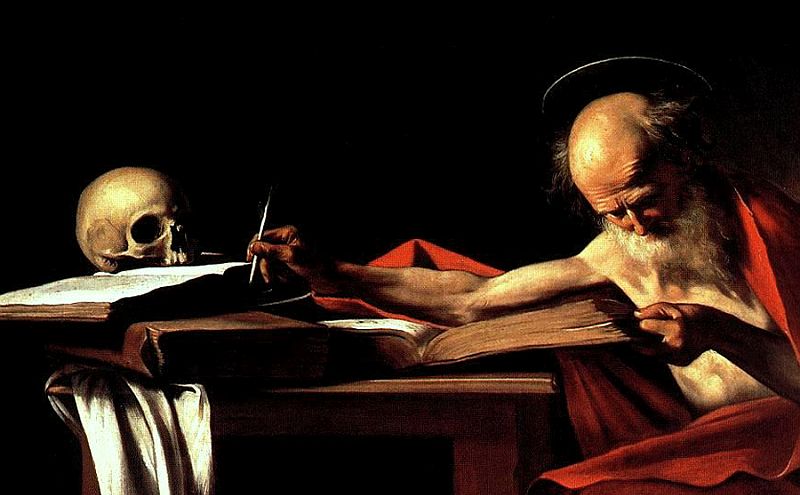
Michelangelo Merisi da Caravaggio, (1571-1610) "Saint Jerome Writing" (Oil on canvas) The production quality was rich. The interior sets were lit like Caravaggio paintings, with at least one referencing his painting of St. Jerome. The Biblical metaphors were nicely handled, even revisiting Jesus Christ Superstar for a fleeting moment or two. The preparation of the 'last supper' and the mysterious person in black that appears in two of the scenes were perfectly subtle. An almost operatic comparison is made to the sacrificial lamb as the plot comes to an end, when the tormented soul of Cristo is finally put to rest. Jesus arrives barely in time to see his lover's murder take place as Cristo tragically dies in the arms of his own savior. Questions of identity in metamodern society are constantly emerging. With more tolerance comes more differentiation. A question: Is how we respect, define and celebrate our differences not what sets us apart to begin with? Are those efforts to be politically correct and tolerant, or accepting of different lifestyles, not the same efforts that will ultimately keep us divided? When will our “Gay” friends, or “Muslim” friends or “Black” friends finally become, just our friends?
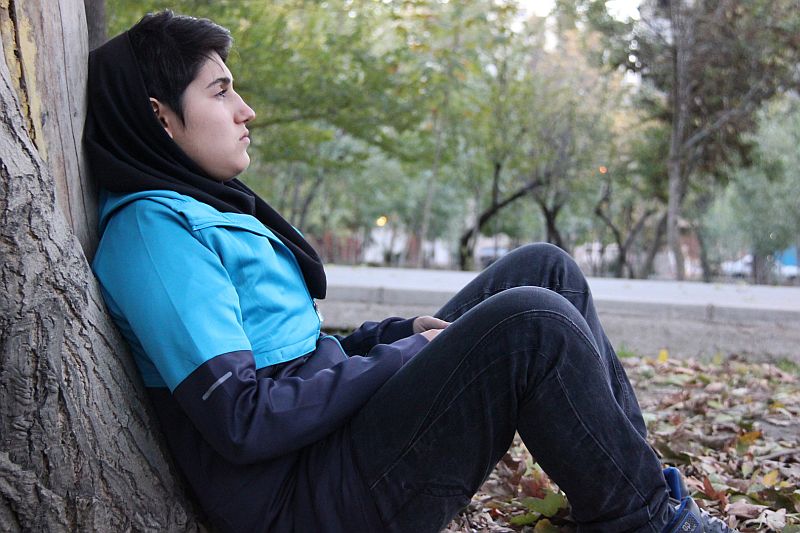
I DON’T LIKE HERE
By Miguel Angel Barroso Image (above) from "I Don't Like Here" The film, I Don't Like Here, denounces the double standards of a seemingly permissive society on the subject of transsexuality, but that in no way is a simple pamphleteer. For a Europeans it may seem shocking that in Iran, the sex-change operation is authorized; but since the arrival to power of Ayatollah Ruhollah Khomeini, after the Islamic Revolution and the defeat of the Shah of Persia in 1979, this kind of operation is given a green light, defending the Islamist regime, after medical and theological consultations, that people have the right to claim the sex to which they feel linked, despite living in a different body. This measure results in Iran being one of the countries in the world where more sex-change operations are carried out, attracting many foreigners who see in this country as the solution to their problems. Taking into account these surprising data that very few know, since the media do not divulge it, it is more than surprising that I Don't Like Here, directed by the young Javad Daraei, who tells the story of a teenager trapped in the wrong body, which, is rejected, not only by Iranian society, but by her own parents who are unable to understand the distressing problem of their daughter. For the young film director, the important thing is to tell a story of love, self-improvement and personal dignity, beyond appearances or machismo established in a society closed to certain personal liberties. And by this I do not mean that in the rest of the world, freedom is absolute or Western democracies are the earthly paradise; There is also machismo and double moral in the West and this is the reason that a film like this one that occupies to us is as singular as daring. It's surprising, the maturity with which Javad Daraei approaches the direction of actors and manages the cinematographic narrative. His eyes are full of love and compassion for fragile beings. How he is and touched by the misfortune of their inevitable destiny is admirable. I Don't Like Here is shot with very few means, but with a very clear idea about the story that wants to tell and how it wants to tell. For example, music is a precise element that instead of being a mere accompaniment, as in most current films, is used with a clear dramatic effect that is part of the crying or laughter of the main character, This teenager who wants to rebel and who fights without rest to defend her masculinity since she was a girl. There are no stereotypes or clichés: the father and mother are exact pieces of this social gear made of apparent social liberties, but cloistered in internal struggles of millennial prejudices, whose intolerance is difficult to overcome. A macho father and a loving mother with her daughter, whom they do not understand at all, despite the fact that their love for her is evident. Another striking point is the staging: sober, intuitive, full of small nuances, wonderful ellipsis that create moments of true poetry, only within the reach of a true filmmaker-author. In I Don't Like Here, he sees himself once and wants more, because his drama envelops us and makes us accomplices, while guilty of our prying and impotent look. How difficult is the combination of drama and tragedy, so as not to result in an excess of false aesthetics or banal resources employed by the more vulgar industrial cinema. The film does not seek the tears of the spectator at any price; He only wants his most intimate emotions, his most discreet and barely discernible tear, his unconditional love that judges no one. And that is the great virtue of this film, which does not make value judgments, nor proclaims blunt sentences that satisfy politicians or institutions of goodwill: love above all, and pain as a final tribute to mistakes made For having their eyes closed to the world around them. I do not think I am wrong, if I declare that this is a great film director, with a world of his own and clear ideas about the art of cinematography.
Traducción Española Para un europeo puede parecer chocante que en Irán, esté autorizada la operación de cambio de sexo; pero desde la llegada al poder del ayatolá Ruhollah Jomeini, tras la Revolución Islámica y la derrota del Sha de Persia en 1979, se da luz verde a este tipo de operación, defendiendo el régimen islamista, después de consultas médicas y teológicas, que las personas tienen derecho a reivindicar el sexo al que se sienten ligado, a pesar de vivir en un cuerpo diferente. Esta medida da lugar a que Irán sea unos de los países del mundo donde más operaciones de cambio de sexo se realizan, atrayendo a muchos extranjeros que ven en este país la solución a sus problemas. Teniendo en cuenta estos sorprendentes datos que muy pocos conocen, ya que los medios de comunicación no lo divulgan, resulta más que sorprendente esta película dirigida por el joven Javad Daraei, que nos cuenta la historia de una adolescente atrapada en el cuerpo equivocado, la cual, es rechazada, no solo por la sociedad iraní, sino por sus propios padres, que son incapaces de entender el problema angustioso de su hija. I Don't Like Here, es un film que denuncia la doble moral de una sociedad aparentemente permisiva en el tema de la transexualidad, pero que de ningún modo es un simple panfleto reivindicador. Para el joven director, lo importante es contar una historia de amor, de superación y de dignidad personal, más allá de las apariencias o el machismo establecido en una sociedad cerrada a ciertas libertades personales. Y con esto no quiero decir que en el resto del mundo, la libertad sea absoluta o las democracias occidentales sean el paraíso terrenal; hay también machismo y doble moral en occidente y esta es la razón de que un film como este que nos ocupa sea tan singular como atrevido. Sorprende la madurez con la que Javad Daraei aborda la dirección de actores y maneja la narrativa cinematográfica. Es admirable su mirada llena de amor y compasión hacia unos seres frágiles y tocados por la desgracia de su destino inevitable. I Don't Like Here está rodada con muy pocos medios, pero con una idea muy clara sobre la historia que quiere contar y cómo la quiere contar. Por ejemplo, la música es un elemento preciso que en lugar de ser un mero acompañamiento, como en la mayoría de las películas actuales, se emplea con un claro efecto dramático que forma parte del llanto o la risa del personaje principal; esta adolescente que se quiere rebelar y que lucha sin descanso para defender su masculinidad desde que era una niña. No hay estereotipos, ni personajes clichés: el padre y la madre son piezas exactas de este engranaje social fabricado de aparentes libertades sociales, pero enclaustrado en luchas internas de prejuicios milenarios, cuya intolerancia es difícil de vencer. Un padre machista y una madre amorosa con su hija, a la cual, no entienden en absoluto, a pesar de que queda evidenciado su amor por ella. Otro punto llamativo es la puesta en escena: sobria, intuitiva, llena de pequeños matices, de maravillosas elipsis que crean momentos de verdadera poesía, solo al alcance de un verdadero cineasta-autor. I Don't Like Here, se visiona una vez y deja ganas de más, porque su drama nos envuelve y nos hace cómplices, a la vez que culpables de nuestra mirada indiscreta e impotente. ¡Qué difícil es la combinación del drama y la tragedia, para no desembocar en un exceso de falsa estética o de recursos banales empleados por el cine industrial más vulgar. La película no busca las lágrimas del espectador a cualquier precio; sólo quiere sus emociones más íntimas, su desgarro más discreto y apenas perceptible, su amor incondicional que no juzga a nadie. Y esa es la gran virtud de este film, que no hace juicios de valores, ni proclama sentencias contundentes que contenten a los políticos o a las instituciones de buena voluntad: el amor por encima de todo, y el dolor como tributo final a los errores cometidos por tener los ojos cerrados al mundo que les circunda. No creo equivocarme, si declaro que estamos ante un gran director de cine, con un mundo propio y unas ideas claras sobre el arte del cinematógrafo.
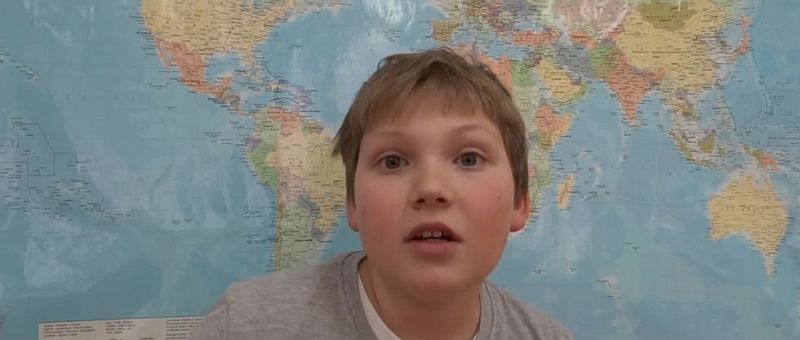
A SMALL STEP FOR A MAN, A GIANT SMILE FOR MANKIND
By Panchali Kar When I watch a movie for writing a review, I tend to focus more on the narrative and the technical aspects. And once in a blue moon there are films which blow my mind in a very different way, which successfully brings down my emotions on my sleeve. A Small Step for a Man, a Giant Smile for Mankind is one of those kinds. This project documents the people of Slovenia from different age groups who have a dream of making the world a better place to live, not just for themselves, but for those who need a hand of support. The documentary includes every age groups, starting from the school going kids to the working professionals, who have taken a step to stand beside others and creating a global brotherhood. Participants of this documentary take up different issues and support them in their own creative form of self expression. We get to know about the school going kid, who volunteers for an initiative to connect with the distressed kids in Syria by writing blogs and sending drawings to them. It is fascinating to see how a kid thinks about what could the dreams of the people living in terror look like, or kids wanting to help out the refugees because they think that no human beings are entitled to live a miserable life with no means.
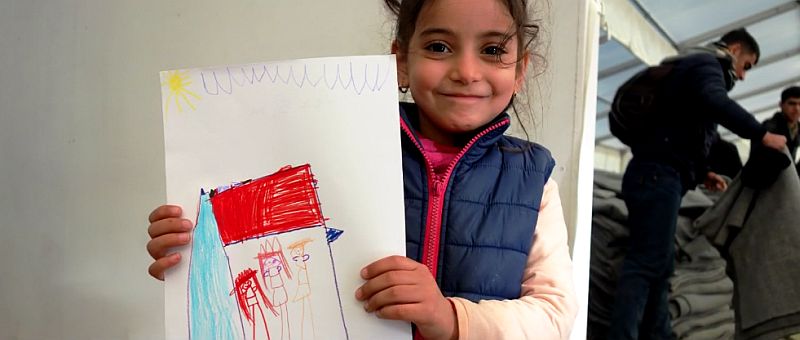
We get to meet the gentleman who spreads awareness about the divulge in the environmental balance due to the overuse of pesticides and insecticides; we get to meet the lady who helps the African kids with learning problems due to lack of infrastructure in schools. We come across the progressive minds who talk about liberalism and acceptance, we cross path with the young chaps who have established a trustful environment for the people with different ethnicity, race, language and colour, and in the end we meet someone who has learned from his own mistake. Over a span of 48 minutes, this film offers a whirlpool of inspirations, wisdom and happiness. Compilation of this documentary was a challenging part as it talks about numerous very important topics. The director has done a good job in dispensing equal share of attention to each of the nuclear stories. The narration is in a straightforward first person perspective, in each of the leaflets of the documentary. Close portraits have been beautifully used to capture the emotions of the subjects as they speak on behalf of their initiatives. The movie begins with a very important message, that we all have some part to play in order to change what is not right, and irrespective of how old we are, how small we are, how insignificant our contribution is in front of the big picture, we must take a step forward and do it anyway. After all, the outcome of a good intention is never futile.

BONSAI
By Yubo Fernández Image (above) from Bonsai, directed by Roberto Aznar This is story of a woman who faces up to a terrible reality. The man who was supposed to love her is the man who tries to cut back all her self-esteem and freedom, the same as a bonsai branches can be cut back because of its owner’s whim. Bonsai is a clean and simple way to show a devastating reality that many woman suffer since a long time ago. The terrible situation of a woman who is psychologically trapped by her husband's manipulating mind. Bonsai are miniature trees no different than any other tree - left on their own they would grow into full-sized trees (much like the trees that composed the forest around our home). But rather than being allowed to reach their fullest size, Bonsai trees are planted in miniature pots, their roots are stunted, and their branches are pruned incessantly. As a result, Bonsai trees never grow to their fullest potential. This is similar to the tragedy that plays in Laura’s (actress Clara Sanchez) life. She might be designed to accomplish great things, and be happy with her daughter, but her life is stunted by her abusive husband. Film director Aznar, did a great job letting us now the aspect of this film in subtle ways without showing extreme violence, but it it still uses a powerful cinematic language; the characters sadness; the sweet innocence of a little girl, and a nun who is the hero who opens Laura’s eyes, and helps her find the way to detach from this abusive and devastating situation. A situation that no child, woman or family member should ever have to pass through. This film should be used to educate women around the world. It could make a big change and have a strong impact on people's lives; in places where a woman's fight for autonomy still rages on.
 Miguel Ángel Barroso is a dedicated and published Film Historian. His credits include organizing numerous international film festivals and authoring several books including “The Hundred Best Films of Italian Cinema History” (2008) and “The Hundred Best Films of the 20th Century” (2009). Miguel organized the videoconference, "The Unforgettable Anna Magnani", in tribute to the actress Anna Magnani on the centenary of his birth, held at the Italian Cultural Instituto Madrid.
Miguel Ángel Barroso is a dedicated and published Film Historian. His credits include organizing numerous international film festivals and authoring several books including “The Hundred Best Films of Italian Cinema History” (2008) and “The Hundred Best Films of the 20th Century” (2009). Miguel organized the videoconference, "The Unforgettable Anna Magnani", in tribute to the actress Anna Magnani on the centenary of his birth, held at the Italian Cultural Instituto Madrid.
Arindam Bhunia is a marketing manager in an MNC with more than eight years of work experience in electrical field. Apart from his corporate job, he has interest in cultural activities so he joined Human Lab Corporation as Chief Executive Officer. He oversees strategic planning for film, television and video game production, marketing and distribution for the company’s business verticals worldwide. He is also responsible for overseeing finance, legal, labour relations, technology and HLC Studio operations.
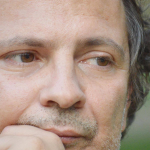 Victor Eustáquio is an award-winning film producer and screenwriter and the Director of Calcutta International Cult Film Festival. A novelist; screenwriter; film producer and composer, Victor currently lives in Portugal and holds a BA in Political Science and a PhD in African Studies. As COO of HLC Studios, Victor coordinates the company’s various distribution strategies to maximize the value of HLC’s content across all current and emerging digital exhibition platforms.
Victor Eustáquio is an award-winning film producer and screenwriter and the Director of Calcutta International Cult Film Festival. A novelist; screenwriter; film producer and composer, Victor currently lives in Portugal and holds a BA in Political Science and a PhD in African Studies. As COO of HLC Studios, Victor coordinates the company’s various distribution strategies to maximize the value of HLC’s content across all current and emerging digital exhibition platforms.
 Panchali Kar is a Dancer, Choreographer, Actor and Filmmaker. In addition, Panchali is a devout advocate for egalitarian social change, is affiliated with the NGO, Responsible Charity and currently working on a photo documentary on LGBT rights. She is an avid scholar and veteran of the performing arts and a seasoned instructor. Panchali maintains several degrees in the Arts including a M.Mus degree. Ms. Kar is also affiliated with AKTO, a Kolkata theater group based in the city in which she resides.
Panchali Kar is a Dancer, Choreographer, Actor and Filmmaker. In addition, Panchali is a devout advocate for egalitarian social change, is affiliated with the NGO, Responsible Charity and currently working on a photo documentary on LGBT rights. She is an avid scholar and veteran of the performing arts and a seasoned instructor. Panchali maintains several degrees in the Arts including a M.Mus degree. Ms. Kar is also affiliated with AKTO, a Kolkata theater group based in the city in which she resides.
 Yubo Fernández is an Actress, script writer, Producer, Director and the Founder and President of Obuy Films. She lived in NYC, attended Atlantic Film School Workshops and returned to study cinematography at Santo Domingo's Altos de Chavon School and studied under Claude Kerven, Chair of the Filmmaking Department at New York Film Academy. “How Do We kill Luisa” and "Peldanos de Dolor" are two films that she's produced. Yubo is also featured in several films from the Dominican Republic.
Yubo Fernández is an Actress, script writer, Producer, Director and the Founder and President of Obuy Films. She lived in NYC, attended Atlantic Film School Workshops and returned to study cinematography at Santo Domingo's Altos de Chavon School and studied under Claude Kerven, Chair of the Filmmaking Department at New York Film Academy. “How Do We kill Luisa” and "Peldanos de Dolor" are two films that she's produced. Yubo is also featured in several films from the Dominican Republic.
Shevaun Cavanaugh Kastl is an award-winning actress, writer and producer currently living in NYC. Her production company, Mad About Pictures, has produced three films all currently playing the festival circuit. "The Mourning Hour", her most recent film, just took top honors at The Williamsburg Independent Film Festival in Brooklyn, NY. She is currently writing a thriller feature but continues to pursue her acting career and can be seen on television and online in episodes of Revenge, Criminal Minds and Heroes.

Sandip Pratihar is an award-winning director, writer and filmmaker. As a screenwriter, director and independent filmmaker, he is very pro-active and follows his calling to communicate artistically intrinsic social messages. From West Bengal, India, Sandip is currently living in Kolkata. He has directed three films all currently playing the festival circuit. The short film "SITA", is his most recent work, just took top honours at sixteen International film festivals.

Daniela Lucato started acting in Padua, Italy. She's lived in Rome, Wellington and Berlin. In 2013 she wrote and directed the theatre piece “Call Me Reality” that debuted in several theater festivals. The Birthday (2014) is her first short film, written and directed in Mandarin and English. "Connecting Fingers" (2015) is her last dance-theatre production and "When I Dance" (2016) is her first feature documentary. Daniela is currently in pre-production on a short film and writing the script for her next feature.



